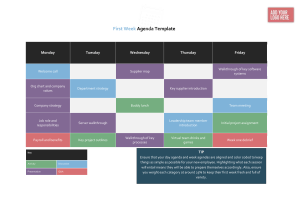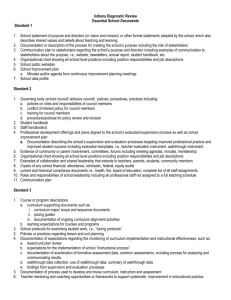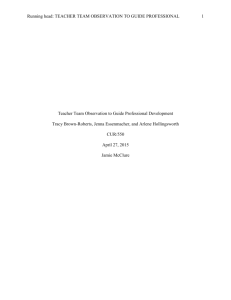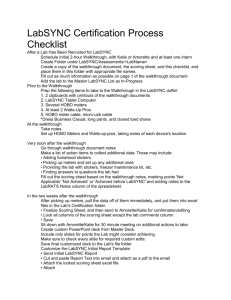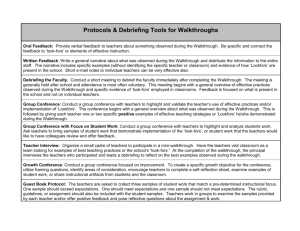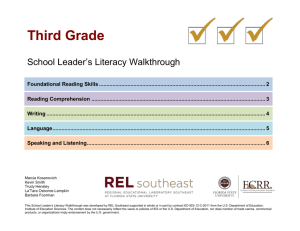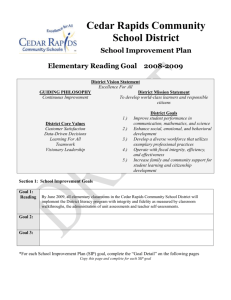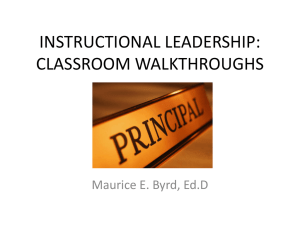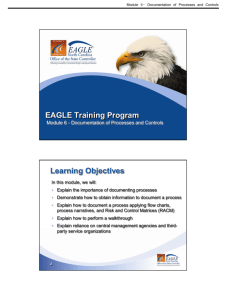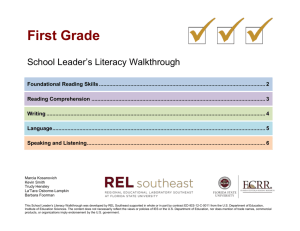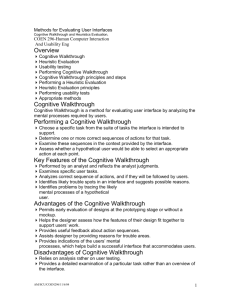NM Classroom Walkthrough - New Mexico State Department of
advertisement
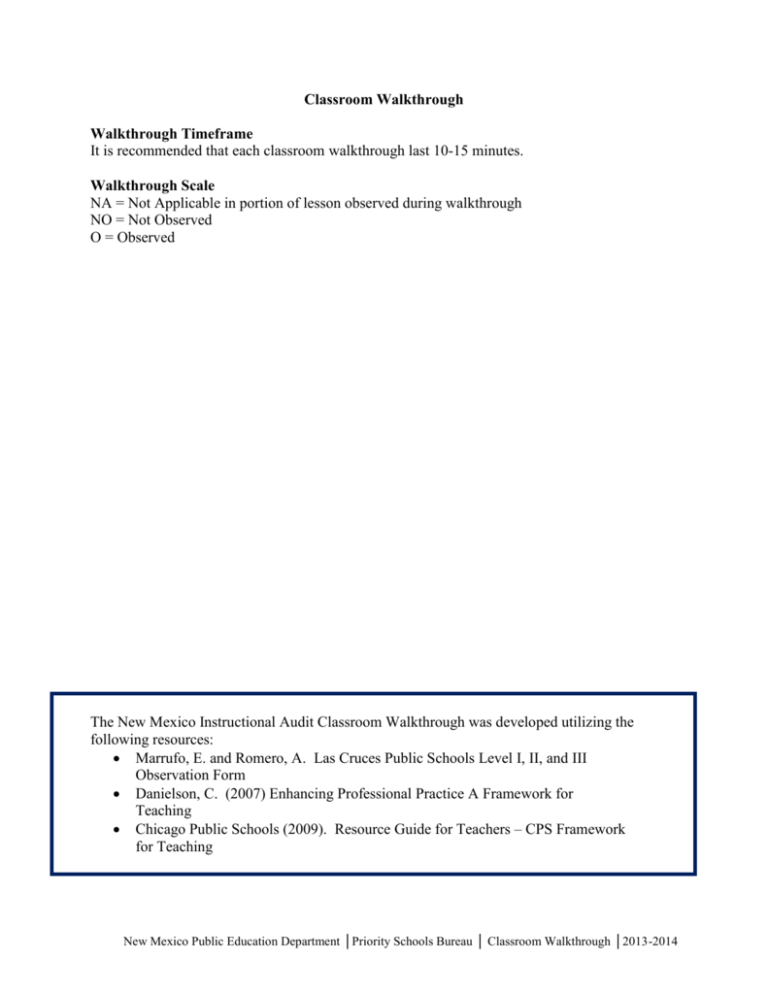
Classroom Walkthrough Walkthrough Timeframe It is recommended that each classroom walkthrough last 10-15 minutes. Walkthrough Scale NA = Not Applicable in portion of lesson observed during walkthrough NO = Not Observed O = Observed The New Mexico Instructional Audit Classroom Walkthrough was developed utilizing the following resources: Marrufo, E. and Romero, A. Las Cruces Public Schools Level I, II, and III Observation Form Danielson, C. (2007) Enhancing Professional Practice A Framework for Teaching Chicago Public Schools (2009). Resource Guide for Teachers – CPS Framework for Teaching New Mexico Public Education Department │Priority Schools Bureau │ Classroom Walkthrough │2013-2014 Classroom Walkthrough School: District: Subject Area: (please include program if applicable) Observer: Observation Date/Period: Grade: Time in Class: Number of students: Estimated # of students on task: How are students grouped during walkthrough? Check all that apply Working independently Working in pairs Working in small groups Whole group Where is the teacher during walkthrough? Check all that apply With individual students With a small group In front of the entire class At desk Domain 1: Planning and Preparation Demonstrating knowledge of content and pedagogy, students, setting instructional outcomes, resources, designing coherent instruction, and student assessments. NA NO O Evidence The plan and practice reflect solid Statements of student learning, not knowledge of the content, prerequisite student activity. relationships between important concepts Learning tasks that require highand of the instructional practices specific to level student thinking and are the discipline. aligned with lesson objectives. Clarity and purpose of lesson. Learning targets are aligned to NM adopted Interdisciplinary connections in standards plans and practice. Instructional targets are stated as Activities aligned with the goals of measurable and observable goals for the lesson. student learning. Incorporation of student interests Leaning is differentiated by scaffolding and events of the day into a lesson. content and academic language for diverse Outcomes of a challenging cognitive learners. level. Multiple materials (textbooks, Outcomes differentiated for students supplementary materials) are used to of varied ability. enhance content knowledge. Lesson and unit plans reflect Assessment is explicitly planned for to important concepts in the discipline ensure student learning outcomes. and accommodate prerequisite Teacher continuously assess both student relationships among concepts and comprehension and learning of all lesson skills. objectives throughout the lesson. New Mexico Public Education Department │Priority Schools Bureau │ Classroom Walkthrough │2013-2014 Domain 2: Creating an Environment for Learning Creating an environment of respect and rapport, establishing a culture for learning, managing classroom procedures and student behavior, and organizing physical space. NA NO O Evidence Teacher states positive, clear expectations High expectations, supported for student behavior prior to learning through both verbal and nonverbal activities that are posted at student eye behaviors. level and are accessible to students. Recognition of quality. Recognition of effort and The teacher has explicitly established persistence. routines/systems for students who are Students actively “working,” rather prepared and ready to start learning tasks at than watching while their teacher the beginning of the class period to include “works”. for transitions to facilitate an organized Circulating to monitor student classroom. learning and to offer feedback. Teacher moves around class visually Smooth functioning of all routines. scanning student’s level of academic Little or no loss of instructional engagement. time. Teacher moves around room and visually Clear standards of conduct, possibly scans student’s self-regulation, interactions posted, and possibly referred to with each other, and cooperation with during a lesson. classroom expectations. Absence of acrimony between Teacher gives frequent verbal and teacher and students concerning nonverbal positive acknowledgement to behavior. individual students and to class. Reinforcement of positive behavior. Teacher provides students with regular Safe environment. opportunities to receive and give feedback on their learning and language. Domain 3: Teaching for Learning Communicating with students, using questioning and discussion techniques, engaging students in learning, using assessment in instruction, demonstrating flexibility and responsiveness. NA NO O Evidence Key vocabulary is introduced, written, High levels of student participation repeated and highlighted for students. in discussion. Questions of high cognitive Teacher elicits responses equitably from all challenge, formulated by both students and allows adequate response students and teachers. time. Questions with multiple correct Teacher is able to provide feedback in a answers, or multiple approaches timely manner that is substantive, even when there is a single correct constructive, aligned to content, and response. specific to each student. Suitable pacing of the lesson: neither Teacher provides students with regular dragging nor rushed, with time for opportunities to receive and give feedback closure and student reflection. on their language and learning. Teacher poses questions to elicit Teacher makes connections between past evidence of student understanding. learning and new concepts. Teacher pays close attention to Teacher visually monitors students work evidence of student understanding. for accuracy, and uses activities, questions, Students assessing their own work clickers, gestures to periodically monitor against established criteria. students’ comprehension and Visible adjustment in the face of demonstration of learning. New Mexico Public Education Department │Priority Schools Bureau │ Classroom Walkthrough │2013-2014 Teacher provides opportunities for students to apply and reflect on their new learning by analyzing, synthesizing, and evaluating information. Teacher uses assessment results (informal, formative, short cycle, quizzes, chapter tests, etc.) to adjust daily activities to meet the instructional needs of students. Teacher monitors student learning by using a variety of teaching strategies. student lack of understanding. Teacher seizing on a teachable moment. Assessment of student attainment. Effective use of physical resources, including computer technology, by both teacher and student.
